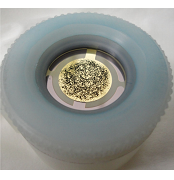
Electrochemical nanogravimetric study on the sorption processes occurring in multiwalled carbon nanotube layers immobilized on a gold surface
The paper authored by
C.E. Moore and
G. Inzelt
is published in Journal of Solid State Electrochemistry (2015, vol. 19, pp. 45–56).
Abstract:
The electrochemical quartz crystal nanobalance (EQCN) was employed to study the potential-dependent sorption of ions, solvent molecules, and aniline in multiwalled carbon nanotubes (MWCNTs) immobilized on gold. During potential cycling, an intense mass increase of the surface layer was observed in sulfuric acid above 0.8 V vs. saturated calomel electrode (SCE) in the beginning, and several cycles were needed to achieve a stable response. A substantial increase of the capacitance of the layer occurred during potential cycling; therefore, the electrochemical activation is an effective method to obtain high capacitance, which can be an alternative procedure of the usual chemical oxidation. This effect was attributed to the incorporation of a large amount of solvent molecules in the deposited MWCNT layer. At high positive potentials, the formation of hydrophilic groups enhances the wetting, and the real surface area increases. After completion of the swelling, a reversible mass change was observed during cycling which can be explained by the sorption-desorption of counterions. Adding aniline caused a well-defined mass increase attesting the sorption of aniline on MWCNTs. It was possible to electrooxidize the sorbed aniline. A polyaniline layer was also prepared by electropolymerization of aniline on the Au│MWCT electrode and characterized. The surface morphology of the layers was also investigated by a focused ion beam scanning electron microscope (FIB-SEM).
